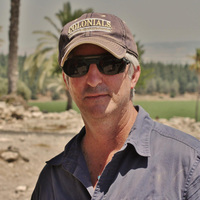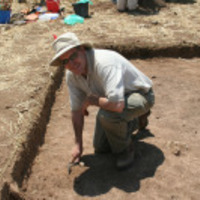
Eric H Cline
Eric H. Cline is Professor of Classics and Anthropology, the former Chair of the Department of Classical and Near Eastern Languages and Civilizations, and the current Director of the Capitol Archaeological Institute at The George Washington University. A Fulbright scholar, National Geographic Explorer, Getty Scholar, and NEH Public Scholar with degrees from Dartmouth, Yale, and the University of Pennsylvania, he is an active field archaeologist with more than 30 seasons of excavation and survey experience in Israel, Egypt, Jordan, Cyprus, Greece, Crete, and the United States, including ten seasons at the site of Megiddo (biblical Armageddon) in Israel, from which he retired after serving as Co-Director with Israel Finkelstein of TAU, and ten seasons at Tel Kabri, where he is currently Co-Director with Assaf Yasur-Landau of the University of Haifa. A two-time winner (2014 and 2018) of the "Nancy Lapp Best Popular Book" Award from the American Schools of Oriental Research (ASOR) and three-time winner of the Biblical Archaeology Society's "Best Popular Book on Archaeology" Award (2001, 2009, and 2011), he and his two co-editors were recently (2019) awarded the G. Ernest Wright Book Award for best edited volume from the American Schools of Oriental Research (ASOR). He is the author, co-author, editor, or co-editor of 22 books, including "The Battles of Armageddon: Megiddo and the Jezreel Valley from the Bronze Age to the Nuclear Age" (2000), "Jerusalem Besieged: From Ancient Canaan to Modern Israel" (2004), "From Eden to Exile: Unraveling Mysteries of the Bible" (2007), "Biblical Archaeology: A Very Short Introduction" (2009), "The Trojan War: A Very Short Introduction" (2013), "1177 BC: The Year Civilization Collapsed" (2014; revised and updated 2021), "Three Stones Make a Wall: The Story of Archaeology" (2017), and "Digging Up Armageddon: The Search for the Lost City of Solomon" (2020), all written for the general public, and "Sailing the Wine-Dark Sea: International Trade and the Late Bronze Age Aegean (1994; 2009), "Amenhotep III: New Perspectives on His Reign" (1998), "Thutmose III: A New Biography" (2006), "Oxford Handbook of the Bronze Age Aegean" (2010), "Ancient Empires" (2011), "The Ahhiyawa Texts" (2011), "Ramesses III: The Life and Times of Egypt's Last Hero" (2012), and "The Social Archaeology of the Levant" (2019), all intended for scholarly audiences. He has also published more than 100 articles and reviews in scholarly journals, books, and festschriften, and recently served for six years as the co-editor, with Christopher Rollston, of the Bulletin of the American Society of Overseas Research (BASOR). One of his lectures based on "1177 BC" has been viewed more than six million times on YouTube; see https://www.youtube.com/watch?v=bRcu-ysocX4&t=3084s.
Phone: (202) 994-0316
Address: 335 Phillips Hall
801 22nd St. NW
Washington, D.C. 20052
Phone: (202) 994-0316
Address: 335 Phillips Hall
801 22nd St. NW
Washington, D.C. 20052
less
Related Authors
Guy D. Middleton
Newcastle University
A. Bernard Knapp
University of Glasgow
McKenzie Hitchcock
US Forest Service
James Newhard
College of Charleston
Sturt Manning
Cornell University
Antonio Perez Largacha
Universidad internacional de La Rioja
InterestsView All (31)






Uploads
Newest by Eric H Cline
(Note that the responses to the article are not included here; they are by Guy Middleton, Raphael Greenberg, Norman Yoffee, Aren Maeir, and Louise Hitchcock, followed by my brief rejoinder.)
(Note that the responses to the article are not included here; they are by Guy Middleton, Raphael Greenberg, Norman Yoffee, Aren Maeir, and Louise Hitchcock, followed by my brief rejoinder.)
Tel Kabri in Israel. Designated as the “Orthostat Building” because of its extensive use
of orthostats and paving slabs found still in situ, the location, plan, and architectural features
of this building raise questions about its function and relation to the palace of Kabri
and its chronological phasing within the palace’s history. The use of orthostats and ashlar
paving stones, which is otherwise rather rare in Middle Bronze Age structures in Canaan,
calls for a reevaluation of the impact of Syrian and Aegean architecture on the Kabri palace,
in view of the already
established Aegean influence on the site. The building, with its
elaborate interior design and features, was erected at the same time that other great architectural
changes took place in the palace of Kabri, including a thickening of the palace
walls. These changes, although possibly simply functional, are also suggestive of deliberate
choices by the palace elite to exemplify their power to the local population while at the
same time attempting to follow the greater Mediterranean trends of their time."
This article made it to the : 10 Most Influential BASOR Articles, see link below
This paper offers an overview of that age of intense connections, focusing especially on Egyptian interaction with the Aegean world during the Middle and Late Bronze Age.
kingdom located in the western Galilee region of modern Israel, lasted from 18 June to
27 July 2017. Highlights of the season included uncovering a courtyard of the palace
with rich material culture deposits; massive architecture belonging to phase 4 of the
palace ("the painted palace"); and additional data on the "northern complex" belonging
to both phase 4 and phase 3 ("the wine palace"). In addition, a solidly built Iron Age
structure was unexpectedly found, located above the MB palace courtyard.
were found cutting into the western part of the Middle Bronze
Age palace. These remains consisted of a segment of a large
structure and a series of sizable pits. Similar Iron Age remains
were unearthed during previous soundings in Areas D and F of
the excavation and were loosely dated to the Iron Age II. The
ceramic assemblage from these soundings demonstrated a
disproportionate number of imports and cooking pots, which
prompted the excavators to suggest that the lower settlement
was engaged in the processing of agricultural products connected
to the nearby forts located elsewhere on the tell. A recent reexamination of the pottery from the previous excavations suggest
that the forts could have only existed during the Iron Age IIA and
IIC. Our examination of the pottery indicates that the imports can
be dated to the Iron Age IIA, while the large number of cooking
pots should mostly be dated to the Iron Age IIC. We would
therefore like to suggest a new interpretation for the function of
the lower settlement at Kabri during the Iron Age II in relation to
the forts and the political reality in the Galilee at that time.